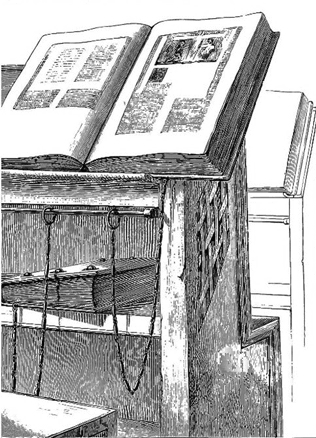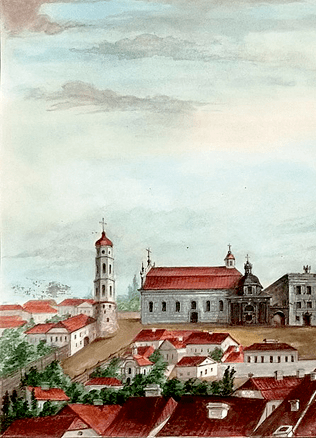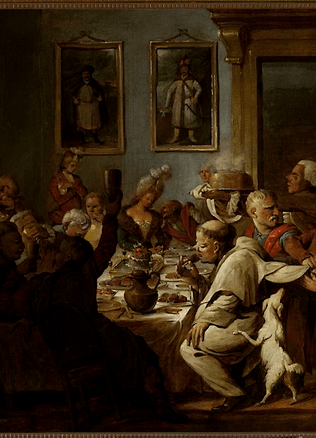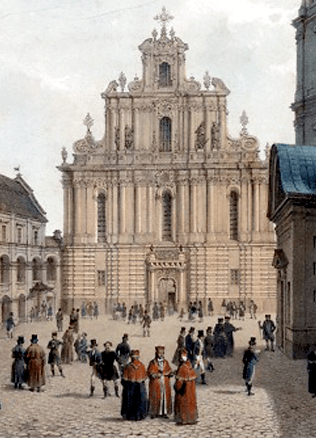The Myth of Ritual Murder
A bloody pan-European flight of fancy
The myth of the ritual killing of Christians, which was in the imaginations of Christians, was a myth whereby Jews would use the blood of a Christian during their Passover rituals (it is a holiday celebrated in spring, and is to commemorate the Jews’ leaving their exile in Egypt). This myth took root and affected all layers of GDL society, and was particularly resilient among city dwellers. The myth of ritual killing known among educated people in Europe was adopted by broader society in the 12th century: the first time Jews were accused of killing a child for ritual needs was in Northwich, England in 1144. Jews being accused of ritual killing became a social phenomenon in Europe already by the 13th century.
Society would retell this story that was anti-Jewish and common around Europe, adding relevant accents determined by the environment and social and cultural developments to the standardized story.
A particular version of the ritual killing of Christians developed in the GDL (and it was this version that became the basis for the spreading of this myth and its adaptation in later periods in the society of Lithuania). The myth of the ritual killing of Christians that came later chronologically became more popular in GDL society. A myth that quickly took hold in medieval Europe, but which we can only find fragments of in the GDL, is the myth of Jews defiling Holy Communion.
The myth of ritual killing spread in GDL society despite its early prevention measures. Based on papal bulls, there were already bans that were entrenched in the first privileges for Jews that Jews were not to be accused of using the blood of Christians.
However, the myth spread, though the official state policy was tolerance, while the Catholic Church refuted these two anti-Semitic myths.
The beginning of accusations of ritual killing in the GDL is tied to the 1660s when it was not only the myth that broke into the open (Narva, 1564) but legal action was taken to make the procedure more difficult to accuse Jews in court, which forced the accusers to think their actions over. Despite attempts to stamp out this myth, it would express itself in GDL society starting in the second half of the 16th century without greater pauses, both among Catholics as well as the Uniates.
Vivid local stories
The effect of the myth of ritual killing on GDL society and particular aspects of the understanding of its plotlines can be seen best when comparing it with classical Western versions of the myth.
Unique changes in the myth of ritual killing appeared quickly in the GDL, with some repeating segments of the myth’s plotline that had already disappeared.
One of them is the idea of Jewish cannibalism (in one court case in the GDL, the witnesses of a suspected ritual killing could not agree upon whether the Jews had “upon stabbing struck and licked the heart after taking it out” or “took out the heart, baked it and ate it.”). In the first known court trial in Narva, a girl had been chosen as the suspected victim of the Jews, though in the classical myth the suspected victim of the Jews was a small (virgin) boy. At the beginning of the 17th century there is mention of adults alongside suspected child victims of Jews. The relationship of society with the suspected victims of Jews, both children and adults, was different in the various versions of the myth that had spread in the GDL. There were efforts to recognise the children as local saints or blessed ones (though they wouldn’t have any canonization or beatification procedures), their bodies were interred in churches, and attracted pilgrims who believed in healing or the fulfilling of wishes; exceptional honour was not shown to adults. The replacing of the child in the myth of ritual killing with the adult in Western societies is seen as a mark of the waning of the myth. The detailed descriptions of bodily wounds of the victim (both children and adults) that was repeated in court cases allow one to believe that society imagined that only blood of a Christian that was tortured in a “suitable way” was used during Jewish rituals. In Polotsk in 1697, with the spread of accusations concerning the ritual killing of a servant girl by Jews, the wounds of hers that were mentioned in court were described in the following way: “There were a number of stabbing and cut wounds, i.e.: (…) the throat and face were cut with knives, the hands and fingers, also the legs below the knees, the calf, the veins, and joints were pierced and cut, (…) the pierced chest let out blood, the stomach was beaten, the neck was tied with three knots.
The descriptions of deadly wounds remained the most vivid, emotional and perfected part of the myth of the ritual killing of Christians that spread in the GDL even when the other parts necessary for an adequate understanding of the myth were not always fully understood in GDL society.
Why did Jews need Christian blood?
The limited understanding of GDL society, the myth’s effect and the social functions that were ascribed to it were best conveyed by the motifs of carrying of the ritual killing of Christians and use of blood, or to be more precise, the lack thereof. The repetition of the suffering of Jesus Christ as the main motif of the ritual killing of Christians is mentioned rarely by GDL society. It is only ascribed to the young suspected victims of Jews. The change of the myth in the GDL forces us to wonder whether society understood the essence of the myth, which was the idea of the periodical imitation of the suffering of Jesus Christ.
It appears that the society of the GDL did not doubt that Jews killed Christians and knew how the ritual takes place, however they could not explain why.
The most common abstract motif of the actions cast upon the Jews was that Christians were supposedly killed in order to get their blood, and use it in unnamed “Jewish” rituals or during Passover (periodically this celebration is called the Jewish Easter in sources). The idea concerning the suspected use of Christian blood in the matzo baked for Passover took root later in the GDL. They began appearing more often in the 18th century, though already in the second half of the 16th century there were hagiographic texts (for example, in Lives of the Saints by Jesuit Piotr Skarga) where there were stories that were suggested reading for Christians about Simon of Trident (1475) and Elizabeth of Punia (1574) where it was mentioned that the blood of Christians was supposedly mixed into matzo dough.
Do You Know?
The GDL took preventive measure to try and stop the spread of the myth that Jews used Christian blood for their rituals. Already the first privileges for Jews banned the accusing of Jews for using the blood of Christians. However, the myth spread, though the official state policy was one of tolerance. The Catholic Church refuted both anti-Jewish myths.
The unchanging explanations of the suspected need for Christian blood and superficial understanding of the idea behind the myth did not lessen the effect of the myth and did not stop it from spreading in GDL society. The myth matched well with the fear that had spread in GDL society concerning the suspected conscious harming of Christians by Jews. The myth of the ritual killing of Christians brought yet another flight of the imagination of society to life, which was the fear of the physical extermination of Christians.
Jurgita Šiaučiūnaitė-Verbickienė



